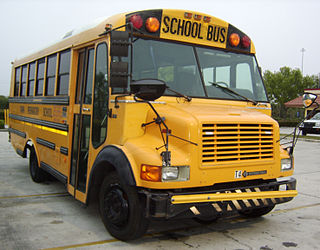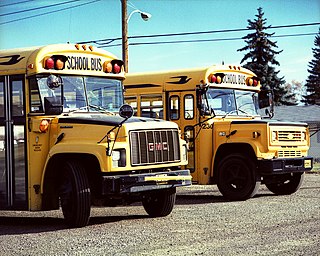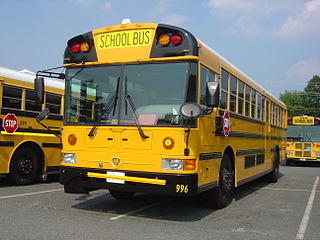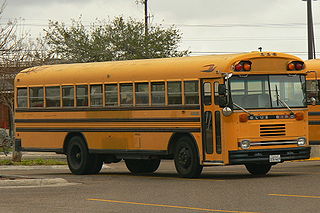
A school bus is a type of bus owned, leased, contracted to, or operated by a school or school district. It is regularly used to transport students to and from school or school-related activities, but not including a charter bus or transit bus. Various configurations of school buses are used worldwide; the most iconic examples are the yellow school buses of the United States and Canada which are also found in other parts of the world.
The Wayne Corporation was an American manufacturer of buses and other vehicles under the "Wayne" marque. The corporate headquarters were in Richmond, Indiana, in Wayne County, Indiana. During the middle 20th century, Wayne served as a leading producer of school buses in North America.

Thomas Built Buses, Inc. is an American bus manufacturer. Best known for its production of yellow school buses, Thomas produces other bus designs for a variety of usages; currently, its production is concentrated on school buses and activity buses and their commercial derivatives.

Carpenter Body Works is a defunct American bus manufacturer. Founded in 1918 in Mitchell, Indiana, the company produced a variety of vehicles, with the majority of production consisting of yellow school buses for the United States and Canada.

IC Bus is an American bus manufacturer. Headquartered in Lisle, Illinois, IC is a wholly owned subsidiary of Navistar International. Established in 2002 by Navistar through the reorganization of subsidiary manufacturer American Transportation Corporation (AmTran), IC currently produces school buses and commercial-use buses for multiple applications.

The Thomas Vista is a model line of buses that was manufactured by Thomas Built Buses from 1989 to 1998. Produced nearly exclusively as a school bus, the model line was also sold in commercial-use configurations. To improve forward sightlines for drivers, the chassis design of the Vista combines elements of conventional buses and transit-style school buses.
Corbeil is a defunct trade name that has been used in bus manufacturing. From 1936 to 1975, J.H. Corbeil was a manufacturer of bus bodies; Les Enterprises Michel Corbeil was a body manufacturer that specialized primarily in school buses, opened from 1985 to 2007. In 2007, the company was acquired out of bankruptcy by Collins Industries and renamed Corbeil Bus Corporation. Serving as the Canadian equivalent of Collins Bus Corporation, manufacturing was shifted from Quebec to Hutchinson, Kansas.
American Transportation Corporation was an American manufacturer of school bus bodies. Tracing its roots to Ward Body Works, AmTran was formed in 1980 following the 1979 bankruptcy of Ward to continue bus production. In 1991, the company became a subsidiary of Navistar International, leading to a series of acquisitions of school bus body manufacturers by chassis suppliers during the 1990s.
The Wayne Busette is a minibus that was assembled by Wayne Corporation from 1973 to 1990. During its production, many examples of the Busette were produced as school buses. One of the first examples produced with a cutaway van chassis, the Busette mated a purpose-built school bus body with a dual rear-wheel van chassis. In North America, this configuration is now preferred by manufacturers for many other types of minibuses in addition to school buses.

The Chevrolet and GMC B series was a series of cowled chassis that were produced by General Motors. Produced across three generations from 1966 to 2003, the model line was a variant of medium-duty trucks marketed under the Chevrolet and GMC nameplates. Initially derived from the medium-duty C/K series, later examples were derived from the GMT530 architecture.

The Thomas Saf-T-Liner is the name of the transit-style school bus product line produced by Thomas Built Buses. Introduced in 1978, the Saf-T-Liner marked the transition to in-house chassis production by Thomas. In addition to school bus applications, variations of the Saf-T-Liner have been produced as activity buses, specialty vehicles, and commercial/transit buses. It can also be used to describe the Saf-T-Liner C2 or Saf-T-Liner FS-65, but they are not considered part of the Saf-T-Liner family.

The Blue Bird Vision is a bus that is manufactured and marketed by Blue Bird Corporation in North America and exported worldwide. In production since 2003, the Vision became the first cowled-chassis bus built on a proprietary chassis designed and manufactured by the same company. While it is sold primarily in a school bus configuration, the Blue Bird Vision is also offered with various commercial and specialty seating and design configurations.

The International 3000 Series is a transit-style bus chassis manufactured by Navistar International, used for school bus and commercial bus applications. In production since 1990, it has been produced in both front and rear-engine configurations.

The Blue Bird TC/2000 is a product line of buses that was produced by the American manufacturer Blue Bird Corporation from 1987 to 2003. Introduced as a second transit-style product range alongside the Blue Bird All American, the TC/2000 was produced in front-engine and rear-engine layouts. While produced primarily as a yellow school bus, Blue Bird offered the TC/2000 in commercial configurations and numerous custom-built variants. For commercial use, Blue Bird badged the model line as the TC/2000 or the APC 2000.
The bus chassis variant of the International S series is a cowled bus chassis that was produced by International Harvester from 1979 to 2001. Produced primarily for school bus applications, the chassis was also produced for other applications, including commercial-use buses and cutaway-cab buses. In addition, the cowled chassis formed the basis for front-engine and rear-engine stripped chassis produced for bus applications.

The Blue Bird All American is a series of buses produced by American bus manufacturer Blue Bird Corporation since 1948. Originally developed as a yellow school bus, versions of the All American have been designed for a wide variety of applications, ranging from the Blue Bird Wanderlodge luxury motorhome to buses for law enforcement use.

The ThomasMinotour is a bus body manufactured by Thomas Built Buses since 1980. The smallest vehicle sold by the company, the Minotour is a bus body designed for cutaway van chassis. Primarily sold for school bus usage, the Minotour is also produced as a MFSAB or in specialized configurations specified by the customer.
Wayne Wheeled Vehicles (WWV) was a tradename of a division of a vehicle manufacturer that specialized primarily in the production of school buses. It was owned by Harsco Corporation, who purchased the rights to use the Wayne brand name, certain product rights, as well as parts and tooling during the liquidation of assets of the Wayne Corporation in late 1992.
The Blue Bird Micro Bird is a bus body produced in the United States and Canada by Blue Bird Corporation. First introduced in 1975, the Micro Bird body is combined with a cutaway van chassis, with passenger capacity ranging from 10 to 30 passengers. While most examples are produced as a school bus, the Micro Bird has been sold in various configurations, including commercial-use minibuses and as a MFSAB. MFSABs are alternatives to 15-passenger vans; examples have come into use by child care centers and other organizations due to updated safety regulations.

The International TerraStar is a product line of medium duty trucks that was manufactured by International Trucks from 2010 to 2015. The smallest conventional-cab truck ever produced by Navistar, the TerraStar is a Class 5 medium-duty truck. Although not officially designated by the company as the replacement for the CityStar LCF cabover, the TerraStar is of similar dimensions and GWVR.












